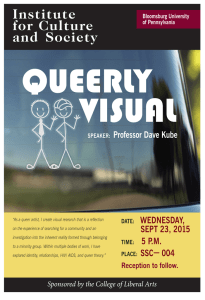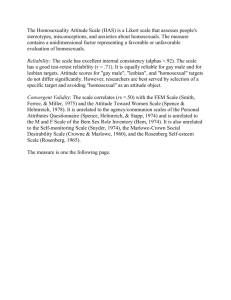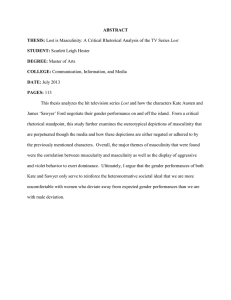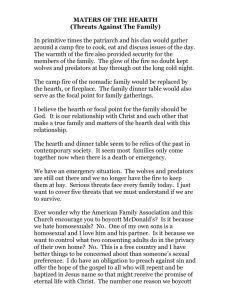Byrne 1 Matthew Byrne Professor Holland
advertisement
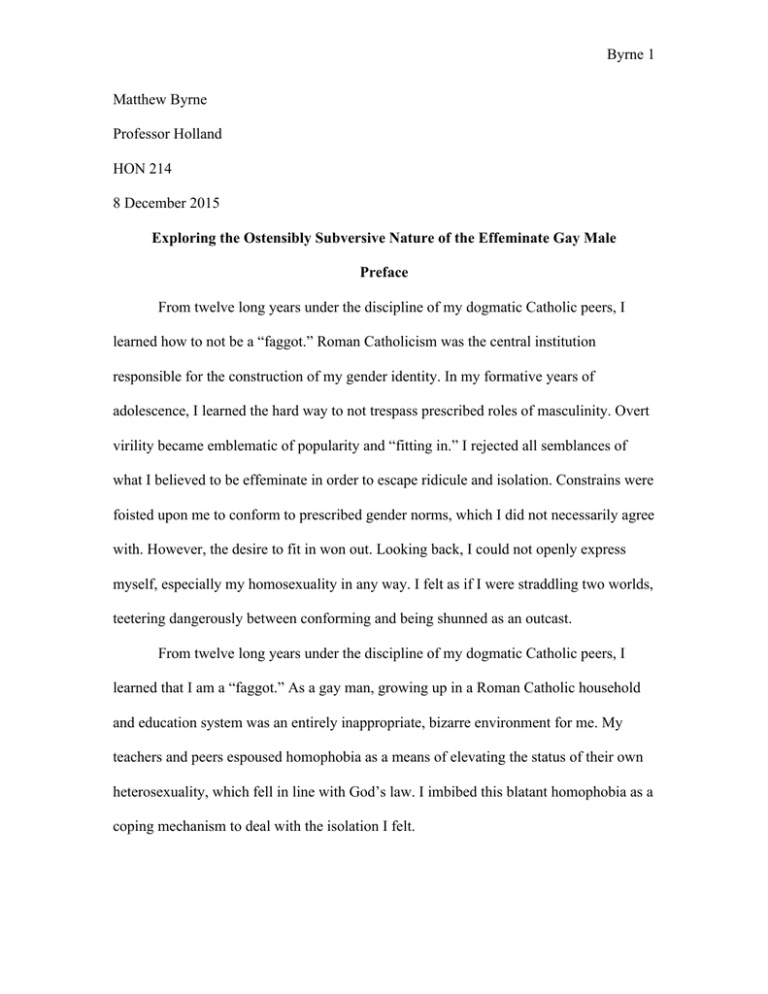
Byrne 1 Matthew Byrne Professor Holland HON 214 8 December 2015 Exploring the Ostensibly Subversive Nature of the Effeminate Gay Male Preface From twelve long years under the discipline of my dogmatic Catholic peers, I learned how to not be a “faggot.” Roman Catholicism was the central institution responsible for the construction of my gender identity. In my formative years of adolescence, I learned the hard way to not trespass prescribed roles of masculinity. Overt virility became emblematic of popularity and “fitting in.” I rejected all semblances of what I believed to be effeminate in order to escape ridicule and isolation. Constrains were foisted upon me to conform to prescribed gender norms, which I did not necessarily agree with. However, the desire to fit in won out. Looking back, I could not openly express myself, especially my homosexuality in any way. I felt as if I were straddling two worlds, teetering dangerously between conforming and being shunned as an outcast. From twelve long years under the discipline of my dogmatic Catholic peers, I learned that I am a “faggot.” As a gay man, growing up in a Roman Catholic household and education system was an entirely inappropriate, bizarre environment for me. My teachers and peers espoused homophobia as a means of elevating the status of their own heterosexuality, which fell in line with God’s law. I imbibed this blatant homophobia as a coping mechanism to deal with the isolation I felt. Byrne 2 For these reasons, I find homophobia to be an especially pertinent topic of discussion. I am interested in excavating the hidden motives behind homophobia in the United States. It functions in much the same subtle ways as racism does. It flourishes in the stereotypes that typify a certain demographic’s behavior and feeds the hatred and fear of a misunderstood demographic. Unlike race, however, sexuality is not an immediately visible trait: it cannot be determined from merely looking at someone. The subcutaneous nature of sexuality allows homosexuals to traverse their lives in anonymity, hiding an integral facet of their identity. I find this idea strikingly similar to the archetypal espionage of Hollywood films: a dapper man in a suit inconspicuously moves through a crowd gathering intelligence as “one of the locals.” This celluloid archetype mimics, to a certain extent, how homosexuals move through their lives in anonymity, testing the waters for how people treat homosexuality. Someone could live their entire life, scared to embrace their identity and content to suffer in the anonymity of “passing.” To a degree, sexuality is a much more difficult attribute to come to terms with, as shown by the resounding rhetoric falsely purporting the success of ex-gay movements to quell undesirable homosexuality. Homosexuals face a certain type of persecution in needing to “pass” as well as if they do not “pass” as heterosexual. Vigilante justice against the abject, perverse, and nefarious homosexual in the sake of an unforgiving god is unabated in countries where religious dogmatism reigns. For this reason, I choose to focus the narrative of my manifesto to examine systems of oppression that work against male queer bodies. In this manifesto, I seek to explore inequality as it pertains to homophobia and how male homosexuality functions as an undermining of normative gender roles, rather Byrne 3 than of heterosexuality, in our contemporary America. This undermining of gender roles, men performing the role of women, highlights the thinly veiled misogyny evident in American society. In order to prevent such subversion, sociocultural policing of gender metes out acts of violence against “delinquent” gay men. Finally, I present a set of necessary changes to adolescent pedagogy regarding sexual and gender identity that would drastically redefine normative masculinity. Although women and gendernonconforming individuals also suffer greatly under this gender normative thinking, I choose to narrow my focus solely to cisgender, homosexual men, since they are the recipients of a uniquely gendered homophobia. Introduction With the landmark 5-4 decision of the United States Supreme Court in the case of Obergefell v. Hodges on June 26th, 2015, same-sex couples were guaranteed the right to marry in accordance with both the Due Process and the Equal Protection Clauses of the Fourteenth Amendment. Labeled “a fundamental right inherent in the liberty of the person” (Obergefell v Hodges 22), gay marriage came to signal a critical turning point in the struggle for equality. No longer would gay men and women feel their relationships were held to a lower standard. No longer would homosexuals have to suffer in anonymity and fear of embracing their identity. And so, nationwide festivities ensued to celebrate and usher in of a new era of equality for gay men and women in the United States. Weeks before the rights of same-sex couples to exercise their right to marry were enshrined in Obergefell v. Hodges, public opinion already appeared to favor marriage equality as “majorities of every ideological group except one – conservative Republicans Byrne 4 – favor[ed] allowing gays and lesbians to marry legally” (PEW Research Center). I felt this overwhelming and growing support for marriage equality as a high school student. A drastic change came over my dogmatic Christian peers who seemed to take to the idea of allowing homosexuals the right to marry outside of the Church. Nevertheless, the difference was palpable. Inevitably, however, there were dissenters. Many shored up conservative values, arguing that the inclusion of same-sex couples into the timeless institution of marriage would demean its inherent value. Homosexuals would, in effect, sully “the sanctity of marriage.” I will largely ignore these arguments as “the sanctity of marriage” was called into question by a number of infamous heterosexuals. Instead, I want to focus on the intriguing dissent from queer people themselves, who examined the issue from a unique perspective, honing in on the social role of marriage, rather than the ostensible gain of liberty. These queer folks, mostly activists, contested the valorization of the family and the institution of marriage as a whole (Spade and Willse; Williams; Zanichowsky). Marriage was, in their eyes, an instrument of inequality, a tool to maintain social class distinctions. In the months, and in some cases years, that led up to the historic Court decision, considerable rhetoric was built around the notion that homophobia and marriage equality were to mutually exclusive concepts. I could not, for example, oppose same-sex marriage, while remaining a proponent of homosexual rights, a concept with which many LGBTQ rights activists took issue (Spade and Willse; Williams; Zanichowsky). Regardless, the precedent was set. Retrospectively examining the zeitgeist, I see that marriage equality was viewed, Byrne 5 to a degree, as a panacea for socially sanctioned injustices to members of the queer community. Affording marriage equality would quell social unrest. Homosexuals would be content. So, I’m forced to wonder. How does the momentous decision to ensure the inclusion of homosexuals into the sacred institution of marriage, which affords a plethora of civil and economic benefits and legally ensures some semblance of equality among heterosexuals and homosexuals, herald a new age of equality? It doesn’t, plain and simple. The fight for marriage equality merely shelves pertinent queer issues, conspicuously ignoring the structural issues that hierarchically organize and subsequently devalue queer lives. This devaluation takes its most visible/substantial form in the plethora of consistent acts of violence perpetrated against queer bodies. Queer populations are at an increased risk for (recurring) experiences of physical abuse, emotional violence, rape, and suicide compared to their heterosexual peers (CDC). After putting forth this troubling statistic, I am –as I hope you are– forced to wonder: why? By providing answers to five questions, I will parse out where violence against queer bodies originates and enumerate how this violence is perpetuated: (1) What defines homosexuality in contemporary American culture? How are homosexuals different? (2) Why do these differences merit violence? (3) How is punishment meted out and perpetuated against the homosexual? And, to conclude, (4) How can we begin to stave off this influx of violence against queer bodies? Byrne 6 Identifying the Queer Body (1) What defines homosexuality in contemporary American culture? How are homosexuals different? Homosexuals are distinguished from heterosexuals by two abstract criteria: their sexual desires and their societal portraits. Since, as stated before, a majority of United States citizens feel no outward animosity towards the idea of homosexuals marrying (PEW Research Center), the public must thereby inherently condone, to a large degree, the amorous and legal unity of a same-sex couple. So, a difference in the societal portrayal of homosexual and heterosexual individuals must be the distinguishing factor between heterosexuals and homosexuals. It is relatively clear to me, as I assume for you, that a certain, prevailing doxa dominates the portraits of homosexuals. Femininity typifies the identity of the gay man, as masculinity does the identity of the lesbian (Lamar and Kite 190). Gay men, therefore, exist in a liminal, marginalized space, where they belong to neither of the two normative, binary genders. Homosexuals straddle two worlds: gay men are gendered as women, but are male, and vice versa. Judith Butler, an American philosopher and queer theorist, explores how mundane actions reify the binary conception of gender and how non-normative sexuality undermines the stability of normative gender by developing the notion of gender performativity in her highly influential, canonical text, “Gender Troubles.” Butler claims that gender is, in fact, “performative.” Rather than an innate, corporeal feature of personhood, gender, she argues, is manufactured through iterations of actions performed by a gender-stylized body (xv). From these performances, gender is retroactively Byrne 7 constructed by social sanctions, thereby enforcing the boundaries of acceptable behavior. Butler abstracts gender from material reality, stating that there are no gendered individuals. Instead it is the actions, or performance, of individuals that create gender: “without those acts, there would be no gender at all” (Performative 522). Gender is “a construction that regularly conceals its genesis” (Performative 522). The hegemony of normative heterosexuality is therefore mindlessly propagated and fortified in the daily actions that ascribe gender to a person. When gay men perform typically feminine actions – showing love for a man, being emotional or sensitive, caring too much about clothes or hygiene – they transgress normative gender and paradoxically elide male and female. A gay man is at once a female and a male. This elision endows gender with a fluid character and further undermines the prevailing binary understanding of gender, which Butler describes as “a preemptive and violent circumscription of reality” (Gender xxiii). Though the nonnormative queer identities breach the material validity of the gender binary, I continue investigating the role of binary, normative gender in the lives of gay men and exploring why transgression of normative gender merits violence. (2) Why do these differences merit violence? Since I have shown that homosexuals are defamed by their prevailing stereotypes as gender-nonconformists, I will now characterize this non-conformity in Foucauldian terms as delinquency, explore “the delinquent” as a social construction, and show why many believe delinquents merit violent punishment. Byrne 8 First, however, I must reinforce the importance of the body and introduce its metaphorical function in society. In many cases, individual bodies are viewed as a synecdochal metaphor for society, where the margins are most dangerous and most vulnerable (Butler 168). Since homosexuals exist in the metaphorical (as well as literal) margins of society, “any kind of unregulated [gender practice] constitute[s] a site of pollution and endangerment” (168). Homosexuals are therefore the “site[s] of pollution and endangerment” in society. In short, gay men threaten social stability in their nonnormative gender practices. Furthermore, this pollution appears to be a recurrent motif as gay men are seen as polluted heterosexual men. Common thought holds that men who act in a typically masculine manner will be heterosexual: “men who are men will be straight” (168). Homosexual men are homosexual, therefore, because they deviate from the norm in gender performance. It is in this deviation that society paints homosexual men as delinquents. Prominent social theorist and philosophical historian of thought Michel Foucault explores how social and theoretical mechanisms within the penile system led to the construction of the “delinquent” in his salient book “Discipline and Punish.” The construction of the delinquent emerged as a “strange manifestation of an overall phenomenon of criminality” (253), in which criminality actually became normalized in the identity of a small group of individuals. The concept of the delinquent, a pathologically and clinically evil figure, cemented the need for “perpetual surveillance of the population” (281) and afforded a uniquely malleable character to the definition of delinquency (283), which allowed for a constant manipulation of what constitutes illegality. By surveilling a population, law-breaking individuals can more easily be Byrne 9 identified and punished for their transgressions. Furthermore, the identification of certain individuals to be delinquents encourages recidivism: “the transformation of the occasional offender to a habitual offender” (272). American society utilizes the figure of the delinquent in much the same way Foucault describes. Operating under traditional gender and sexual norms, American society manipulates the plastic definition of “delinquency” to include all those who engage in non-normative sexual practices. Homosexuals are subsequently labeled as delinquents, a label which they cannot escape much in the same way that criminals cannot escape their own identity as law-breakers. Instead of a police record or a criminal passport like Foucault mentions (272), however, homosexuals are “outed” as homosexual. Their own inherently inescapable sexual identity becomes a badge of delinquency. In this manner, delinquency is imbued in any gay man’s identity. As active threats to society, gay men merit punishment. In summary: once gendered as feminine according to their performance, gay men are unceremoniously shoved into matrices of normality, which measure and “hierarchize” them “in terms [. . .] of value,” and categorically devalue them as mere sexual delinquents. This heteronormative judgment “compares, differentiates, hierarchizes, homogenizes, [and] excludes” (Foucault 183) homosexuals from the normal heterosexual individual, on the basis of their gender performance. Queer bodies are, therefore, distinct from the normal heterosexual and easily punished for their subversive sexual delinquency: a dangerous threat that merits punishment. Byrne 10 Punishing the “Outed” Queer Body (3) How is punishment meted out and perpetuated against the homosexual? Since I have shown that queer bodies are characterized as delinquents who threaten social stability, I will now investigate how violence is meted out and perpetuated against “the delinquent” homosexual. Butler’s conception of gender performativity complicates the prevailing notion of a gender binary, implying a large degree of fluidity between masculinity and femininity. So, we must wonder how normative gender is indoctrinated in men. Since gender is fluid in nature, men require a concrete means of solidifying their masculinity, so as to ensure proper conformity with gender norms. Furthermore, the omnipresent nature of gender, something we are continually performing in our actions, highlights this need to prove one’s masculinity. I argue that normative gender practices are socially indoctrinated in men through the policing of gender practices. Men are disciplined to reject feminine behavior, since they exist in a panoptic matrix, in which their masculinity is continually policed. In “Discipline and Punish,” Foucault delineates the social function of the Panopticon, a penitentiary building constructed by English philosopher and social theorist, Jeremy Bentham. Bentham ingeniously developed an idyllic prison, in which a prisoner “is seen, but [. . .] does not see [and] is the subject of information [but] never a subject in communication” (Foucault 200). Bentham’s Panopticon functions as a “laboratory” (203) and a highly efficient surveillance mechanism, in which the sense of constant surveillance (whether real or constructed) is imbued in the prisoner. The building’s construction allowed it to be “used as a machine to carry out experiments, to Byrne 11 alter behaviour, to train or correct individuals” (Foucault 203). Foucault argues that this Panopticon quietly pervades society in derivative forms as the prevailing surveillance and disciplinary mechanism. A French sociologist specializing in social theory, Loïc Wacquant, builds on the Foucauldian notion of “delinquency” and argues that police institutions in America have come to specifically target marginalized (delinquent) groups of society in his “Crafting the Neoliberal State.” He critiques the Foucauldian notion of power as capillary in his work, noting that “‘devices for normalization’ anchored in the carceral institution have not spread through the society in the manner of capillaries, irrigating the entire body social [. . .] Rather, the widening penal dragnet [. . .] has been remarkably discriminating, [. . .] it has affected essentially the denizens of the lower regions of social and physical space” (Wacquant 205). Power, according to Wacquant, is more accessible to certain demographics; I claim that gender normative, heterosexual males better access power due to their status. Subsequently, power is most heavily exercised on those who occupy the lowest rungs of the figurative social ladder. Though Wacquant specifically investigates how the police channel their punishments on the urban, black poor (205), I argue that the same channeling of punishments applies to gender non-normative gay men, since this group also inhabits the “lower regions of social and physical space” (205). To the same end, I want to highlight how the panoptic, disciplinary policing of gender is exercised and channeled onto queer bodies. The gender performativity of queer people is critically examined to ensure conformity with normative gender. It is only in performing feminine actions that gay men Byrne 12 are punished. Panoptic power is exercised upon gender non-conforming gay men to “train” and “correct” (Foucault 203) their delinquent gender practices. According to Butler, “under conditions of normative heterosexuality, policing gender is sometimes used as a way of securing heterosexuality” (Butler xi). American sociologist C. J. Pascoe in her ethnography, “Dude, You’re a Fag,” explores this policing of gender along with the topic of gender identity as it pertains to male homosexuality. Pascoe rehashes some key Foucauldian notions as she claims that policing masculinity, most commonly seen in the deployment of homophobic invectives, is merely a “supervision of normality” (Pascoe 296). In her ethnography, she argues that high school boys lobby homophobic epithets not to demonstrate hatred of homosexuals or opposition to gay rights, but rather to police masculinity, divest their peers of masculinity, and assert their own masculinity. This idea maps neatly onto the Foucault’s panoptic surveillance as perpetuating normative masculinity relies heavily on feeling as if you are under constant surveillance. Men feel a continual need to prove their masculinity, to reject any semblance of being a “faggot.” In general, this policing of masculinity takes its most obvious form in the joking relationship of boys (60). Perhaps what is most frightening about this claim is its connection with Foucault’s notion of a “silent, mysterious, [and] unperceived vigilance,” leading to a “general surveillance of the population” (Foucault 280). Young boys are subtly reaffirming normative masculinity by self-policing masculinity and policing the masculinity of other boys. This indoctrinates young boys with an arbitrary set of gender practices, which must be continually upheld, or else they run the risk of anti-gay violence. These stereotypical constructions of masculinity and homosexuality are instilled in the minds of boys at a young age. Byrne 13 In response to this violence, gay individuals have taken to attempting to “pass” as heterosexual to avoid punishment for their delinquency, adopting normatively masculine behavior in order to hide their homosexuality and subsequently avoid punishment. This desire to conform to socially sanctioned gender norms erase queer identities and reinforces the validity of gender as a material reality. A specter is haunting American men: “the specter of the fag” (Pascoe 52). Men, women, and children have banded together in an unholy alliance against the abnormal, gender-nonconforming, effeminate homosexual man. It’s time men redefined masculinity for themselves instead of mindlessly rehashing and reaffirming the normative masculinity of their fathers and grandfathers. Why have societal perceptions of femininity evolved without a symmetric transformation of masculinity? Is normative gender so deeply vertebral to ourselves that we cannot allow men to change their perspectives of themselves? I refuse to continue these harmful gender norms, and I implore you to do the same. Homophobia should not be synonymous with masculinity. Conclusion (4) How can we stave off this influx of violence against queer bodies? Though toppling these heterosexist structures appears daunting, I insist that the importance of compiling this manifesto is not only to explore what it means to live in a queer body in contemporary America, but also to present a theoretical framework for the institution of systematic changes to adolescent sexual and gender identity pedagogy in order to safeguard vulnerable queer bodies. We know that there are serious consequences to homophobia and the policing of masculinity. Research investigating school shootings found that the majority of school Byrne 14 shooters who go on rampages have been subjected to homophobic teasing (Kimmel and Mahler 1439). These boys who opened fire were “mercilessly and routinely teased and bullied and that their violence was retaliatory against the threats to manhood” (1439). This statistic demonstrates the powerful role of masculinity in the lives of all boys. When this central facet of their identity comes under fire, drastic consequences seem to rise. So, how do we stop this? Although laws cannot be enacted to end the typification of queer bodies as delinquents, authority figures must make significant changes to the portraits of queer individuals in adolescent sexual and gender pedagogy. Parents and authority figures in an adolescent’s life must start using adult-oriented language when discussing homophobia. Since homophobia is at its core merely fear of transgressing gender norms, as I have shown, children must be raised in an environment where gender and sexual identity are neither binary nor imposed. Gender and sexual conformity are extracted from an assortment of coercive social norms. Furthermore, a change in rhetoric regarding children teasing other children for being gay, imagined or not, must be implemented. When teachers, parents, and authority figures describe the homophobic taunts deployed by boys, they use a word that conveniently sequesters these hateful sentiments to childhood: “bullying.” The implication is that this “harassment,” a much more appropriate word, is absent from the adult world. However, as I have discussed, the policing of masculinity does not take place in a vacuum. The adult world is not rife with equality between heterosexuals and homosexuals, or people of color and whites, or men and women. Moreover, the word bully inaccurately implies a distinction between the heterosexual bullies and the bullied Byrne 15 homosexuals. Just as gender presents itself as a fluid construct, so does masculinity and, subsequently, homosexuality. Any man or boy can be subjected to anti-gay violence, even if they are not gay themselves, since this violence originates in perceived femininity. Though some changes are much more easy to enact, it is crucial that I reinforce the importance of adopting a bottom-up approach to harassment and punishment of queer bodies. Rather than instructing adults on proper treatment of queer individuals, we must teach children to obliterate both the binary conception of gender and the assumption of heterosexuality as superior to all other sexualities. In summary, the defamatory doxa of LGBT individuals that pervade contemporary American society have created a vigilante sociocultural police system that works against emissaries of disorder: any individual who strays from normative logic. Even with the advent of marriage equality, this normative logic centers on the necessity of a body to perform in a certain manner so as to conform to gender norms. When a body does not conform, the complex sociocultural framework of gender normativity legitimizes the use of violence, allows for all kinds of violations of human rights, and leads to social hatred and fear of homosexuals. It is for this reason that violence against homosexuals is justified and continues unabated. The violence meted out against LGBT individuals today evinces a profound erasure of queer identities. Byrne 16 Works Cited Butler, Judith. Gender Trouble: Feminism and the Subversion of Identity. New York: Routledge, 1990. Print. ---. "Performative Acts and Gender Constitution: An Essay in Phenomenology and Feminist Theory." Theatre Journal 40.4 (1988): 519-31. JSTOR. Web. 08 `Dec. 2015. Foucault, Michel. Discipline and Punish: The Birth of the Prison. New York: Vintage, 1995. Print. Kimmel, Michael S., and Matthew Mahler. "Adolescent Masculinity, Homophobia, and Violence: Random School Shootings, 1982-2001." Am Behav Sci American Behavioral Scientist 46.10 (2003): 1439-458. SAGE Publications. Web. 9 Dec. 2015. Obergefell v. Hodges. 14 United States Supreme Court 1-103. United States Supreme Court. 26 June 2015. Supremecourt.gov. Web. 30 Nov. 2015. Pascoe, C. J. Dude, You're a Fag: Masculinity and Sexuality in High School. Berkeley: U of California, 2007. Print. PEW Research Center. "Support for Same-Sex Marriage at Record High, but Key Segments Remain Opposed." Pew Research Center for the People and the Press RSS. PEW Research Center, 08 June 2015. Web. 01 Dec. 2015. Spade, Dean, and Craig Willse. "Marriage Will Never Set Us Free." Organizing Upgrade. Organizing Upgrade, 6 Sept. 2013. Web. 6 Oct. 2015. Wacquant, Loïc. "Crafting the Neoliberal State: Workfare, Prisonfare and Social Insecurity." Sociological Forum 25.2 (2010): 197-220. Print. Byrne 17 Williams, H. Powell. "Is Marriage Equality a Conservative Victory." Public Seminar. Public Seminar, 14 July 2015. Web. 6 Oct. 2015. Zanichkowsky, Anders. "Why I Oppose Marriage Equality." Web log post. AZanichkowsky. WordPress, 26 June 2013. Web. 6 Oct. 2015.
